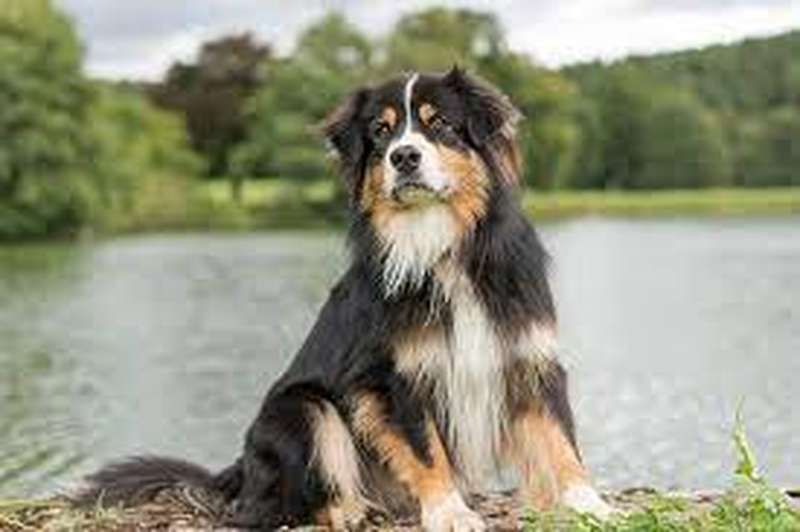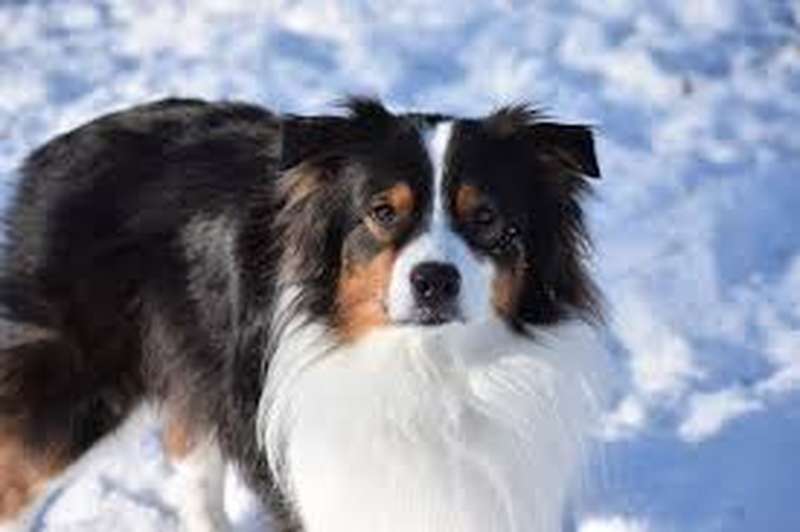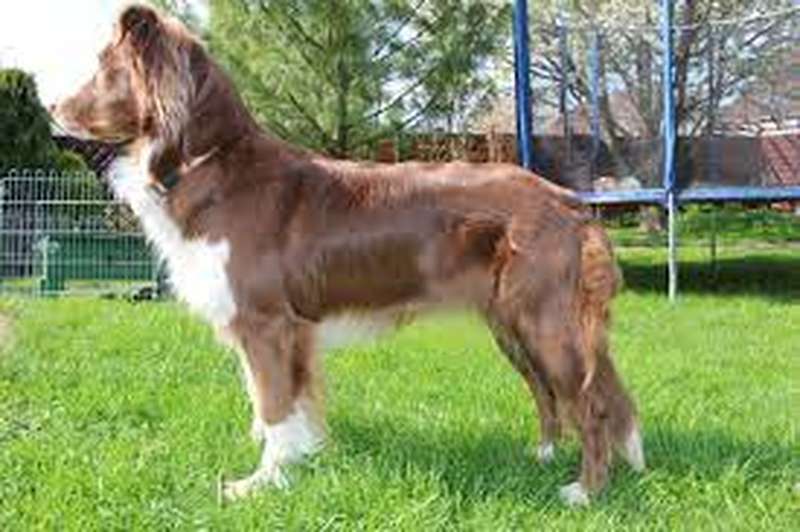Australian Shepherds, also known as “Aussies” to their friends, are known for their sweet nature, strong work ethic, and high energy levels. Contrary to their name, this breed is of American origin and is renowned for their association with cowboys and their appearances in films and rodeos.
Four Common Shades of Australian Shepherds

Australian Shepherds are officially recognized in four different colors. Any colors other than these four are considered mixed breeds. Many kennel clubs may disqualify dogs with color combinations that deviate from the standard.
Australian Shepherds are recognized for their coat colors, which include four accepted variations:
- Black
- Blue Merle
- Red
- Red Merle
You may have noticed that the title mentions the presence of 10 distinct Australian colors. While these four colors represent the primary color groups, it is important to note that each group consists of several variations.
Let us delve deeper into each primary color category and explore their exquisite variations.
A Solid Black Australian Shepherd
The solid color in Australian Shepherds is determined by a recessive gene, making it uncommon for them to be born with just one color.
While it may be unlikely, it is not impossible to find completely black Australian Shepherds in various settings, such as ranches and suburban sidewalks, without any markings.
An Australian Shepherd doesn’t need to be completely flawless to be considered a solid color, but any white or tan markings will be very subtle.
Black Australian Shepherds typically have brown eyes, although the specific shades may range from light to dark.
On rare occasions, you may come across a completely black Australian Shepherd with mesmerizing hazel eyes flecked with gold. And if you do take a picture, be sure to capture the moment.
Bicolor Black Australian Shepherd
The term “black bicolor,” often abbreviated as “black bi,” is used to describe an Australian Shepherd that has a coat with only black and white colors.
This variation is also commonly known as a Black & White Australian Shepherd. The coat of a black and white Australian Shepherd is typically white from its face to its front paws, while the rest of its body, from the back of its head to its tail, is solid black.

Additionally, it may possess white “points” in the form of color spots located above its eyes.
Certain black Australian Shepherds exhibit tan as their secondary color instead of white. A black-and-tan Australian Shepherd may display tan spots on various parts of its body, such as the eyes, cheeks, throat, chest, or legs.
Although they have two colors, they cannot be classified as “black bi” because that term is used explicitly for white-secondary Australian Shepherds.
Black, Tri-Color Australian Shepherd
A black tri Australian Shepherd, also known as a three-colored black Australian Shepherd, displays white and tan highlights.
The white markings are commonly found on the muzzle, chest, stomach, and paws of the animal. On the other hand, the tan marks are most noticeable on its eyes, cheeks, and legs.
The black tri Australian Shepherd is highly favored among the various coat colors within the Australian Shepherd breed. Their eyes are light to dark brown, as black is the dominant color.
Solid Red Australian Shepherd.
The red gene is recessive, meaning it is only expressed in the absence of the dominant black gene.
Breeding Red Australian Shepherds can be more challenging, but this only adds to the value and uniqueness of these beautiful dogs.
Aussie coats have the ability to grow in various shades of red. Cinnamon, the lightest shade, appears almost golden in certain lighting conditions, whereas the darkest shade, liver, resembles a dark grey or black color.
Red Australian Shepherds can come in various shades, such as auburn, chestnut, ruby, and more.
Solid-red Australian Shepherds are the rarest among all Aussies because the red gene is recessive and solid-colored Aussies are already considered rare. Meeting one is definitely a cause for celebration!
Red Bicolor Australian Shepherd
Similar to black bi, red bi also refers to an Australian Shepherd that has a coat with red and white coloring.

Red bi Aussies typically have white markings on their faces, chests, legs, and occasionally on the backs of their necks. Their body color will be entirely red, starting from the forelegs and extending backward.
All Australian Shepherds with a red bicolor coat have a combination of red and white fur. Red Australian Shepherds without any white markings, whether solid or merle, do not have tan markings.
Red Tricolour Australian Shepherd
The red tri Australian Shepherd is characterized by its coat, which is predominantly red and white, with distinct copper points and markings.
Red tricolors can have white markings on their paws, fronts, and faces in addition to their base red coats. It is common for these markings to be accompanied by copper highlights, which are most likely to appear on the face and legs.
Amber is the most common eye color among all three types of red Australian Shepherds, and it beautifully complements their coats.
Certain Australian Shepherds, commonly referred to as “red Aussies,” possess the distinctive trait of having blue eyes.
Some individuals even possess heterochromia, a condition where one eye is amber, and the other eye is blue.
Blue Merle Australian Shepherd
The dominant pattern gene in Australian Shepherds is Merle, which means you are more likely to see it than solid black or red coats.
If you’re unfamiliar with the term, “merle” refers to a coat pattern characterized by a marbled appearance. This pattern is achieved by layering lighter and darker shades, resulting in a visually appealing and blended effect.
Merle Aussies can exhibit either black or red coat colors. However, if a black Australian Shepherd possesses the merle gene, it is referred to as a blue merle instead.
If you examine the picture closely, you will understand why it appears blue from a distance. The black spots blend with patches of grey, creating an overall blue hue.
The coat of a solid blue merle Australian Shepherd is marbled throughout.
The shades of grey on a dog can vary from charcoal to silver; sometimes, you can even find a combination of these shades on the same dog. Aussies with this coloration are both rare and unforgettable.
Blue Merle Bicolor Australian Shepherd
A blue merle Australian Shepherd can have either tan or white markings and its marbled base color.
The combination of white and blue merle in a dog’s coat can range from a subtle single patch on the chest to a more extensive coverage that includes the dog’s chest, forelegs, and middle.
I am interested in blue merle and tan dogs. Australians occasionally make appearances.
These animals possess tan or copper points on their eyebrows and sometimes sport tan beards, which lends them an air of distinction.
Blue Merle Tricolour Australian Shepherd
Blue Merle tri. Australian Shepherds are a highly sought-after purebred known for their distinctive color combinations.
These dogs are truly stunning, with their white ruffs and faces, tan cheeks, ears, legs, and beautiful cloudy blue merle pattern running down their backs.
Only a select few breeds of dogs can excel in kennel club shows and rodeo contests, and Australian Shepherds are among them.
Blue merle is a coat color pattern found in certain dog breeds. Australian Shepherds typically have blue or brown eyes, and occasionally they may have one of each color.
Interestingly, their eyes can have a marbled pattern similar to their fur.
Red Merle Australian Shepherd
The dog has a red Merle coat. Australian Shepherds are the result of a combination of a merle pattern gene and a red color gene. When a black coat is marbled, it produces a beautiful cloudy blue-gray appearance.
On the other hand, marbling a red coat creates a unique and striking sandstone effect. It will remind you of the untamed outback, where your Australian ancestors started herding sheep.
A solid red merle Australian Shepherd does not necessarily require perfect marbling throughout its entire body.
Before a coat color is officially considered different, having a few patches of copper and white is acceptable.
The dog’s coat color is a red merle. Australian Shepherds frequently possess marbled eyes, characterized by colorful flecks in their irises that give them a captivating and intense gaze.
The dominant colors in these dogs are blue with brown marbling, brown with blue marbling, and in some exceptional cases, one of each.
Tricolour Merle Red Australian Shepherd
The red merle tricolor Australian Shepherd has a beautiful combination of a marbled red base with tan highlights and white trim. The white fur can cover various parts of their bodies, including their faces, chests, legs, and occasionally bellies.
On the other hand, the copper color is most prominent above their eyes and on the tips of their paws.
One fascinating and significant fact about the Merle gene is its unique characteristics. Responsible breeders will never intentionally breed two merle dogs together. There is a potential risk that if two merles mate, they may produce a litter of puppies with excessive white fur.
As Australian Shepherds grow, they may experience various health issues such as poor eyesight, impaired hearing, and discomfort if they lack pigmentation near their ears and eyes.
Unrecognized Colours
The American Kennel Club does not accept specific colors of Australian Shepherds. Although these patterns are typically associated with mixed-breed dogs, they can still appear in purebred Australian Shepherd lines. However, they are determined by extremely rare recessive genes.
- Aussies with diluted coats have a gene that lightens their standard coat colors, resulting in a much lighter appearance. The color black changes to blue, red changes to beige, and merles become lighter. Although dilute coloration can be a health concern in other breeds, Australian Shepherds are not currently affected by this issue.
- As mentioned earlier, white Australian Shepherds can be produced by breeding two merles together. Breeders who prioritize the well-being of their dogs steer clear of breeding litters of white Australian Shepherds due to their tendency to have health issues.
- Yellow Australian Shepherds bear a striking resemblance to Golden Retrievers. The possible shades range as extensively as the red and black options, encompassing hues from light yellow to a deep, sandy gold bar. The yellow gene alters the base color in all body areas except the nose. Yellow Australian Shepherds with black or mahogany noses are commonly observed. Yellow Australian Shepherds can also exhibit white patches.